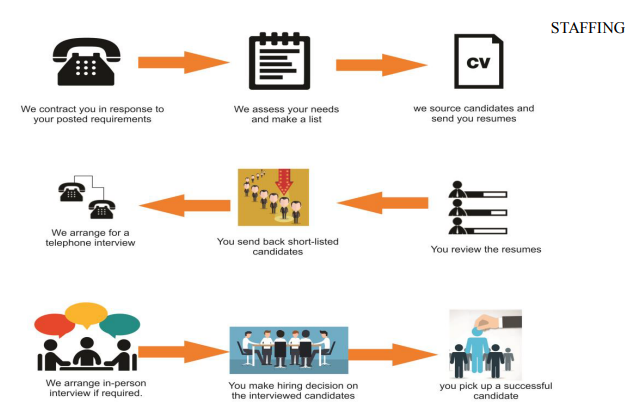What is Staffing?
Staffing is process of hiring best people for the organization and allotting a specific work based on their skill to perform it. It covers procurement, development. Compensation, integration and maintenance of people in the organization to achieve individual, organizational and social goals.
Table of Content
- 1 What is Staffing?
- 2 Meaning of Staffing
- 3 Nature of Staffing
- 4 Importance of Staffing
- 5 Staffing Process-Steps involved in Staffing
- 6 Manpower Planning
- 7 Recruitment
- 8 Selection
- 9 Orientation and Placement
- 10 Training
- 11 Remuneration of Employees
- 12 Performance Appraisal
- 13 Promotion and Transfer
- 13.1 Promotion
- 13.2 Purposes of Promotion
- 13.3 Types of Promotion
- 13.4 Transfer
- 13.5 Need and Purpose of Transfer
- 13.6 To adjust the workforce
- 13.7 To provide relief
- 13.8 To punish employees
- 13.9 Types of Transfers
- 13.10 Production transfer
- 13.11 Shift transfer
- 13.12 Replacement Transfer
- 13.13 Remedial Transfer
- 13.14 Versatility Transfer
- 13.15 Benefits of Promotion and Transfer
- 14 FAQ
Staffing simply stated, is finding the right people for the right job. A very important aspect of management is to make sure that the right people with the right qualifications are available at the right places and times to accomplish the goals of the organisation.
Meaning of Staffing
The term staffing may be defined as the managerial function of hiring and developing the required personnel to fill in various positions in an organization. This function involves the determination of the size and categories of staff requirement.
It is also concerned with employing the right type of people and developing their skills through training. The staffing function focuses on maintaining and improving the manpower in an organization.

The managerial function of staffing involves manning the organization structure through proper and effective selection, appraisal and development of the personnel to fill the roles assigned to the employers/workforce.
Nature of Staffing
The managerial function of staffing is of a continuous nature. The managers have to give attention to the staffing needs of the organization. The staffing policy of the organization has to be developed on the basis of long term requirements of the organization.

Nature of Staffing can be explained by the following characteristics:
Staffing is an important managerial function
Staffing function is the most important managerial act along with planning, organizing, directing and controlling. The operations of these four functions depend upon the manpower, which is available through staffing function.
Staffing is a pervasive activity
As staffing function is carried out by all mangers and in all types of concerns where business activities are carried out.
Staffing is a continuous activity
This is because staffing function continues throughout the life of an organization due to the transfers and promotions that take place.
The basis of staffing function is efficient management of personnel
Human resources can be efficiently managed by a system or proper procedure, that is, recruitment, selection, placement, training and development, providing remuneration, etc.
Staffing helps in placing right men at the right job
It can be done effectively through proper recruitment procedures and then finally selecting the most suitable candidate as per the job requirements. Staffing is performed by all managers depending upon the nature of business, size of the company, qualifications and skills of managers, etc.
In small companies, the top management generally performs this function. In medium and small-scale enterprise, it is performed especially by the personnel department of that concern.

Importance of Staffing
Importance of staffing can be explained with the help of the followings:
Key to other managerial functions
It is seen that function of staffing is closely related to managerial business areas which influences direction and control in organization.
Building healthy human relationships
It builds required man-power relationships in an organization. With smooth human relation, excellent coordination and communication takes place.
Human resources development
For any business establishment, hardworking and skilled man-power is always welcomed which serves as an asset of business concern.
Long Term effect
The performance of the company depends upon the effective decision making quality. It is noted that skilled, laborious and well-motivated people becomes an asset to an organization.
Potential contribution
The idea about staff selection depends upon the ability of effective employees which can manage future challenges which is needed by an organization.

Staffing Process-Steps involved in Staffing
Following are the steps involved in staffing:
Manpower requirements
It is seen that the first step towards staffing is planning of good manpower which will match the need of particular work.
Recruitment: As per the demand from the organization, the applications of concerned workers are entertained as per invitations by company to the desired candidate.
Recruitment
As per the demand from the organization, the applications of concerned workers are entertained as per invitations by company to the desired candidate.
Selection
After receiving applications from candidates, they are scanned as per suitability of position and candidature.
Orientation and Placement
After offering the job to the candidate, the initial work is to made the candidate familiar with working style and environment.
Training and Development
Training is part of incentives which is given to worker so as to frame and grow as per the concern. It involves working capability and scope.
Remuneration
It is a sort of compensation which is paid by the concern to the new joiners. It depends on nature of job skilled or unskilled, physical or mental, etc.
Performance Evaluation
Performance evaluation is a method which will show candidate record such as behavior, attitudes and progress. It involves regular assessment based on reports from different departments.
Promotion and transfer
It involves transfer in job sector and level which depends on past performance of the candidate. It is non- monetary incentive.
Manpower Planning
It is termed as Human Resource Planning which concerns with the matching of correct number and correct kind of people at correct place at correct time with correct things that will suit to get organizational goals. Human Resource Planning has an important place in the arena of industrialization.
Human Resource Planning should take on a systems approach and should be carried out as a set procedure.

Steps in Manpower Planning
Following are the steps for manpower planning:
Analyzing the current manpower inventory
Before a manager makes forecast of future manpower, the current manpower status has to be analyzed. For this, the following things have to be noted:
- Type of organization
- Number of departments
- Number and quantity of such departments
- Employees in these work units.
Based on this information, the manager analyses the needs of each department and then moves on to future forecasting.
Making future manpower forecasts
Once the factors affecting the future manpower forecasts are known, planning can be done for the future manpower requirements in several work units
The Manpower forecasting techniques commonly employed by the organizations are as follows
Expert Forecasts
This includes informal decisions, formal expert surveys and Delphi technique.
Trend Analysis
Manpower needs can be projected through extrapolation (projecting past trends), indexation (using base year as basis) and statistical analysis (central tendency measure).
Workload Analysis
It is dependent upon the nature of workload in a department, in a branch or in a division.
Work Force Analysis
Whenever production and time period has to be analyzed, due allowances have to be made for getting net manpower requirements.
Other methods
Several Mathematical models, with the aid of computers, are used to forecast manpower needs, like budget and planning analysis, regression and new venture analysis.
Developing employment programmess
Once the current inventory is compared with future forecasts, the employment programmes can be framed and developed accordingly, which will include recruitment, selection procedures and placement plans.
Design training programmes
These will be based upon extent of diversification, expansion plans, development programmes, etc. Training programmes depend upon the extent of improvement in technology and advancement to take place. It is also done to improve upon the skills, capabilities and knowledge of the workers.
Recruitment
“Recruitment is the process of searching the candidates for employment and stimulating them to apply for jobs in the organization.” Recruitment is the activity that links the employers and the job seekers.
According to Dale Yoder of Stanford University, recruitment can be defined as:
It is the process to discover sources of manpower to meet the requirement of staffing schedule and to employ effective measures for attracting that manpower in adequate numbers to facilitate effective selection of an efficient working force”.

“Recruitment of candidates is the function preceding the selection which helps to create a pool of perspective employees for the organization so that the management can select the right candidate for the right job from this pool. The main objective of the recruitment process is to expedite the selection process.
Recruitment Process
Recruitment process is the first step towards creating the competitive strength and the strategic advantage for the organizations. Recruitment process involves a systematic procedure from sourcing the candidates to arranging and conducting the interviews and requires many resources and time.
- Identify vacancy.
- Prepare job description and person specification.
- Advertise the vacancy.
- Manage the response.
- Short-list candidates
- Arrange interviews.
- Conduct interview and decision-making analysis activities.
Factors Affecting Recruitment
The internal forces or factors are the factors that can be controlled by the organization. In addition, the external factors are those factors, which cannot be 81 controlled by the organization implementing recruitment programmes and procedures by filling up vacancies with best qualified people.
Internal Factors Affecting Recruitment
The internal forces i.e. the factors that can be controlled by the organization are:
- Recruitment Policy
- Human Resource Planning
- Size of the firm
- Cost
- Growth and Expansion
Types and Sources of Recruitment
Recruitment is of two types are :
1.Internal Recruitment
It is a recruitment, which takes place within the concern or organization. Internal sources of recruitment are readily available to an organization. Internal recruitment may lead to increase in employee?s productivity as their motivation level increases.
It also saves time, money and efforts. But a drawback of internal recruitment is that it restricts the organization from inviting new blood. In addition, not all the manpower requirements can be met through internal recruitment. Hiring from outside has to be done. There are primarily three internal sources for recruitment:
- Transfers
- Promotions
- Re-employment of ex-employees
2.External Recruitment
External sources of recruitment have to be solicited from outside the organization. External sources are external to a concern. However, it involves lot of time and money. The external sources of recruitment include:
- Employment at Factory Level
- Advertisement
- Employment Exchanges
- Employment Agencies
- Educational Institutions
- Recommendations
- Labor Contractors
Selection
Selection is the process of putting right men on right job. It is a procedure of matching organizational requirements with the skills and qualifications of people. Effective selection can be done only when there is effective matching. On selecting appropriate candidate for particular job, the organization will receive quality performance and more output.
It saves time and increases productivity with less wastage. While selecting a good candidature, a screening of candidate is done at the time of selection procedure.

It is seen that a selection is different from recruitment since both are related with employment process. With recruitment, the motivation exists with several candidates applying for particular job profile. On the other hand, selection exists as reverse process which is not correct as it detained candidates.
Distinction between Recruitment and Selection
| Sr. No. | Basis | Recruitment | Selection |
| 1 | Meaning | It is an activity of establishing contact between employers and applicants | It is a process of picking up more competent and suitable employees. Objective It encourages large number of candidates for a job. It attempts at |
| 2 | Objective | It encourages large number of candidates for a job | It attempts at rejecting unsuitable candidates |
| 3 | Process | It is a simple process. | It is a complicated process. |
| 4 | Hurdles | The candidates do not have to cross many hurdles. | Many hurdles have to be crossed. |
| 5 | Approach | It is a positive approach. | It is a negative approach. |
| 6 | Sequence | It precedes selection. | It follows recruitment. |
| 7 | Economy | It is an economical method | It is an expensive method. |
| 8 | Time Consuming | Less time is required. | More time is required. |
Employee Selection Process
The employee selection process takes place in the following order:
- Preliminary Interviews
- Application blanks
- Written Tests
- Employment Interviews
- Medical examination
- Appointment Letter
Orientation and Placement
Once the candidates are selected for the required job, they have to be fitted as per the qualifications. Placement is said to be the process of fitting the selected person at the right job or place, i.e. fitting square pegs in square holes and round pegs in round holes.
Once he is selected for the job, he is given the activities he has to perform and told about his duties. The freshly appointed candidates are then given orientation in order to familiarize and introduce the company to him. Generally, the information given during the orientation program me includes:
- Employees layout
- Type of organizational structure
- Departmental goals
- Organizational layout
- General rules and regulations
- Standing Orders
- Grievance system or procedure
Once the candidates are selected for the required job, they have to be fitted as per the qualifications. Placement is said to be the process of fitting the selected person at the right job or place, i.e. fitting square pegs in square holes and round pegs in round holes.
Once he is selected for the job, he is given the activities he has to perform and told about his duties. The freshly appointed candidates are then given orientation in order to familiarize and introduce the company to him. Generally, the information given during the orientation program me includes:

Once the candidates are selected for the required job, they have to be fitted as per the qualifications. Placement is said to be the process of fitting the selected person at the right job or place, i.e. fitting square pegs in square holes and round pegs in round holes.
Once he is selected for the job, he is given the activities he has to perform and told about his duties. The freshly appointed candidates are then given orientation in order to familiarize and introduce the company to him. Generally, the information given during the orientation program me includes:
Training
Training of employees takes place after orientation takes place. Training is the process of enhancing the skills, capabilities and knowledge of employees for doing a particular job. Training process molds the thinking of employees and leads to quality performance of employees. It is a continuous and never ending in nature.

Importance of Training
Training is crucial for organizational development and success. It is fruitful to both employers and employees of an organization. An employee will become more efficient and productive if he is trained well. Training is given on four basic grounds:
- New candidates who join an organization are given training. This training familiarizes them with the organizational mission, vision, rules and regulations and the working conditions.
- The existing employees are trained to refresh and enhance their knowledge.
- If any updating and amendments take place in technology, training is given to cope up with those changes, e.g. purchasing new equipment, changes in technique of production, computer apartment. The employees are trained about use of new equipment and work methods.
- When promotion and career growth becomes important, training is given so that employees are prepared to share the responsibilities of the higher level job.
Benefits of Training
The benefits of training can be summed up as:
- Improves morale of employees
- Less supervision is required
- Fewer accidents occur
- Chances of promotion
- Increased productivity
Ways/Methods of Training
Training is generally imparted in two ways:
On job training:
On the job training methods are those which are given to the employees within the everyday working of a concern. It is a simple and cost effective training method. The in proficient as well as semi- proficient employees can be well trained by using such training method.
The employees are trained in actual working scenario. The motto of such training is “learning by doing.” Instances of such on-job training methods are job-rotation, coaching, temporary promotions.

Off job training
Off the job training methods are those in which training is provided away from the actual working condition. It is generally used in case of new employees. Instances of off the job training methods are workshops, seminars, conferences, etc. Such method is costly and is effective if and only if large number of employees have to be trained within a short time period.
Off the Job training is also called as vestibule training, i.e. the employees are trained in a separate area (may be a hall, entrance, reception area, etc., known as a vestibule) where the actual working conditions are duplicated.

Remuneration of Employees
In job, remuneration refers to as reward or compensation which is distributed to an employee based on their working capability and performance. It shows basic attraction to an employee in order to work professionally and successfully.
In job, a salary serves as an important source of income for employees with which the standard of their living depends. Different salaries are there for different levels in an organization.

So it is seen that the amount and remuneration serves as an important aspect for both management and employees.
Methods of Employee Remuneration
1.Time Rate Method
In this, remuneration is linked directly with amount of time devoted by employee on particular work. The amount of payment can be hourly, daily,weekly or monthly irrespective of their output. This of course is the simplest method of remuneration where there appears minimum wastage of resources and low accidental charges.
It is the best way to generate quality output and is favorable for new employees. It gives motivation to employee?s unity as employees of a particular group/cadre get equal salaries.
2.Piece Rate Method
This method relates with method of compensation where remuneration is paid on basis of pieces generated or produced by an employee.
In this, the determination of employee cost/unit is not hard as their salary varies with output. Since the salary here depends on employee output, so this method helps in improving the morale of employees. With this type of method, the work efficiency increases.
Performance Appraisal
A performance appraisal, employee appraisal, performance review or career development discussion is an approach where a job performance of an employee is calculated by its immediate manager or supervisor.

A performance appraisal is a part of building and managing career development. It is the process of obtaining, analyzing and recording information about the relative worth of an employee to the organization.
Performance appraisal is an analysis of an employee’s recent successes and failures, personal strengths and weaknesses and suitability for promotion or further training.
It is also the judgment of an employee’s performance in a job based on considerations other than productivity alone.
Aims of Performance Appraisal
Generally, the idea of performance appraisal is to:
- show employees feedback based on their workability
- find the employee training requirements
- layout the criteria applied in order to give organizational rewards
- design the ground for personnel issues such as salary increases, promotions, disciplinary actions, bonuses, etc.
- give an opportunity for organizational diagnosis and development 113
- make possible communication among employee and administration.
- confirm the techniques involved in selection and human resource policies to match federal requirements.
- enhance performance by way of counseling, coaching and working.
Advantages of Performance Appraisal
The performance appraisal has following advantages
Promotion
It will help supervisors to think about promotions for particular employee based on his/her capability.
Compensation
It helps in listed out compensation packages for employees based on their performance result.
Compensation
It helps in listed out compensation packages for employees based on their performance result.
Selection validation
It helps an employer to know about the efficiency and importance of selection process by knowing its strengths and weaknesses.
Selection validation: It helps an employer to know about the efficiency and importance of selection process by knowing its strengths and weaknesses.
Communication
It helps to build an effective communication model among employees and employers.
Motivation
In this, the performance appraisal will work as motivation tool.
Promotion and Transfer
Promotion is said to be an incentive in which the worker is shifted to a higher job with higher salary and demanding bigger responsibilities. Transfer is a case of shifting the workers and transferring them to different work units and branches of the same organization.

Promotion
A few companies do have a clear-cut policy while certain organizations issue circulars as and when they need. Many companies develop policies over a period through settlements and agreements with the workers/unions. In promoting employees, consideration should be given for establishment of the horizontal or vertical promotion.
The desirability of securing assistants who complement rather than supplement their superiors is the major point in a successive plan, which is an integral part of manpower planning. According to Dale Yoder, it is a “movement to a position in which responsibilities and presumably the prestige are increased.
Promotion involves an increase in rank ordinarily; promotion is regarded as a change that results in higher earnings, but increased earnings are essential in a promotion.”
This definition talks of both vertical and horizontal promotions. According to Scott and Clothier, “A promotion is the transfer of an employee to a job which pays more money or one that carries some preferred status.
” Therefore, a promotion may be defined as: “an upward advancement of an employee in an organization to another job, which commands better pay/ wages, better status/prestige and higher opportunities/challenges, responsibility and authority, better working environment, hours of work and facilities and a higher rank.”
Purposes of Promotion
- To motivate employees to higher productivity.
- To attract and retain the services of qualified and competent people.
- To recognize and reward the efficiency of an employee.
- To increase the effectiveness of the employee and of the organization.
- To fill up higher vacancies from within the organization.
- To build loyalty, morale and a sense of belonggingness in the employee.
- To impress upon others that opportunities are available to them also in the organization, if they perform well.
Types of Promotion
- Horizontal Promotion: Promotion involves an increase in responsibilities and pay and a change in designation. However, the employee concerned does not transgress the job classification, e.g. a lower division clerk is promoted as an upper division clerk. This type of promotion is referred to an upgrading of the position of an employee.
- Vertical Promotion: A promotion is vertical when a canteen employee is promoted to an unskilled job. The concerned employee naturally transgresses the job classification.
- Dry Promotions: Dry promotion refers to increase in responsibilities and status only.
Transfer
Pigors and Meyers: Consider transfer as “the movement of an employee from one job to another on the same occupational level and at about the same level of wages or salary” No appreciable change in task or responsibility is expected.
Scott and others define transfer as “the movement of an employee from one job to another. It may involve a promotion, demotion or no change in job status other than moving from one job to another.”
A transfer may be defined as a change in job within the organization where the new job is equal to the old in terms of pay, status and responsibilities: T.N. Chhabra.
A lateral shift causing movement of individuals from one position to another usually without involving any marked change in duties, responsibilities, skills needed or compensation: C.B.Gupta.
Need and Purpose of Transfer
To meet organization needs: Companies may transfer employees due to
- Change in volume of production
- Change in technology
- Change in production schedule
- Change in product line
- Change in organization structure
To satisfy the employee needs: Employees may request their transfer due to
- Dislike of boss or fellow workers
- Lack of opportunities for future advancement
- Personal problems
To better utilize employees
- The employee maybe transferred because the management feels that his capabilities would be better utilized elsewhere.
- An employee who is not performing satisfactorily may be more suitable in another job.
To make the employee more versatile: The employees may be transferred to different jobs to
- Widen their knowledge and skills.
- Reduce monotony and as a method of training
To adjust the workforce
Workers are transferred from the surplus department or plant where there is shortage of staff.
To provide relief
It gives relief to the employees who are overburdened or doing risk work for long period.
To punish employees
- Employees indulging in undesirable activities may be transferred to remote places or to some other jobs.
- It is in the form of disciplinary action.
- Transfers are made because permanent stay may cause frauds, bribery, etc.
Types of Transfers
Transfers may be classified into five types
1.Production transfer
2.Shift transfer
3.Replacement transfer
4.Remedial transfer
5.Versatility transfer
Production transfer
Such transfers are made when there is a need of manpower in one department and surplus manpower in the other Such transfers help to stabilize employment.
Shift transfer
Employees may be shifted from one shift to another for personal reasons, e.g. marriage, infant care, old parents.
Replacement Transfer
It is used when all operations are declining and to retain long-service employees as long as possible. The longstanding employee replaces a new employee and thereby gets relief from the heavy pressure of work.
Remedial Transfer
Such transfers are made to rectify mistakes in selection and placement. These transfers are affected at the request of the employees and are, therefore, called personal transfer.
Versatility Transfer
It is affected to make employees versatile and competent in more than one skill. It helps to reduce boredom and monotony.
Benefits of Promotion and Transfer
- Useful in productivity and effectiveness of the organization
- Greater job satisfaction to employees
- Stabilization of fluctuating work needs
- Improved employee skills
- Remedy for faulty placement
- Improved labor relations
FAQ
What is Staffing?
Staffing is process of hiring best people for the organization and allotting a specific work based on their skill to perform it. It covers procurement, development. Compensation, integration and maintenance of people in the organization to achieve individual, organizational and social goals.
